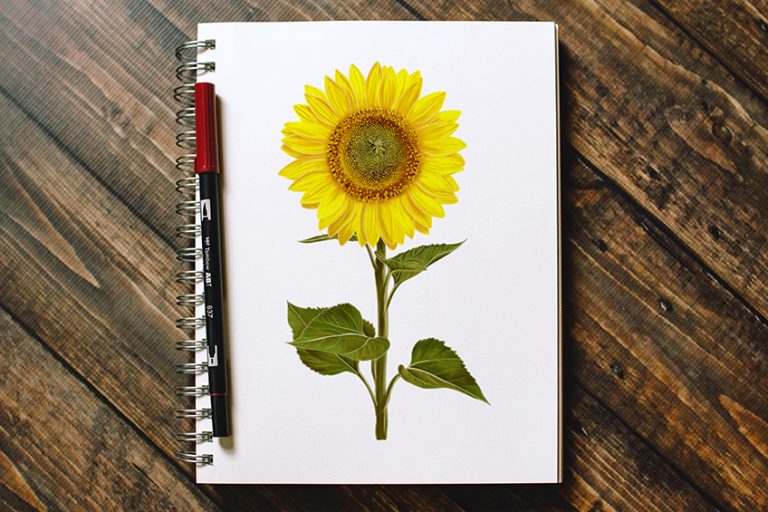How to Draw a Daffodil – Create a Floral Narcissus Portrait
This post may contain affiliate links. We may earn a small commission from purchases made through them, at no additional cost to you.
Daffodils, scientifically known as narcissus flowers, are gorgeous bulb flowers that bloom once a year in springtime. The narcissus genus of plants take their name from the mythical youth who, having fallen in love with his own reflection, stared at it until he died, and was transformed by the gods into a flower. These lovely blooms are also said to be an inspiration for the flower illustrations of Alice in Wonderland because they almost have personalities of their own! In this how-to-draw-a-daffodil tutorial, you will learn the 15 steps that it takes to create an easy daffodil sketch!
Table of Contents
- 1 How to Draw a Daffodil Flower in 15 Easy Steps
- 1.1 Step 1: Draw the Foundation of Your Daffodil Outline
- 1.2 Step 2: Create the Central Petal Outline of Your Realistic Daffodil Drawing
- 1.3 Step 3: Add an Outer Layer of Petals to Your Narcissus Drawing
- 1.4 Step 4: Continue Building the Body of Your Daffodil Illustration
- 1.5 Step 5: Add the Stem to Your Daffodil Outline
- 1.6 Step 6: Apply the Base Coat to Your Daffodil Flower Drawing
- 1.7 Step 7: Apply the Base Coat to Your Narcissus Drawing
- 1.8 Step 8: Apply Texture to the Petals of Your Realistic Daffodil Drawing
- 1.9 Step 9: Continue Creating Texture on the Petals of Your Narcissus Drawing
- 1.10 Step 10: Add Shading to Your Daffodil Flower Drawing
- 1.11 Step 11: Continue Shading the Petals of Your Daffodil Illustration
- 1.12 Step 12: Create Highlights on Your Daffodil Art
- 1.13 Step 13: Add More Color to the Stem of Your Daffodil Sketch
- 1.14 Step 14: Blend the Colors of Your Daffodil Illustration
- 1.15 Step 15: Complete Your Daffodil Flower Drawing
- 2 Frequently Asked Questions
How to Draw a Daffodil Flower in 15 Easy Steps
Any art project requires some sort of planning. In today’s drawing lesson, we focus on the basic steps to creating a realistic daffodil drawing. You will be instructed on how to create an outline your daffodil illustration, following which, you will learn how to use color, shading, and texture to emulate the structure of the narcissus flower to make your daffodil art seem very realistic! Have a quick look at the image that follows as it shows every step in this tutorial.

Much of the instruction in this how-to-draw-a-daffodil tutorial will focus on the color phase of your realistic daffodil drawing. You will be taught how to use different shading texture techniques to make a narcissus drawing come to life. This tutorial was created using paint. However, you as the artist can decide which medium you prefer to work with – our tutorial is very flexible and adaptable! Gather your art supplies and get settled because it is time to start step one!
Step 1: Draw the Foundation of Your Daffodil Outline
For the first step of your narcissus drawing, you will create the foundation outline of your daffodil sketch. The daffodil flower has two petal layers. The foundation circle you are about to draw will be the petal outline of the daffodil crown. Once this is in place, you will be able to create the focus-flower petals. Start by drawing a medium-sized circle in the center of your canvas or page. If you are using a digital design tablet, you will need to make the foundation lines on separate layers so that you can erase them later on. If you will be using a medium such as acrylic paint, the foundation lines should be drawn using a light, erasable pencil.

Step 2: Create the Central Petal Outline of Your Realistic Daffodil Drawing
In this step, you will create the outline for the central set of petals. Following the overall shape of the foundation circle, use a jagged line to emulate the daffodil flower petal. See the example below for guidance.

Step 3: Add an Outer Layer of Petals to Your Narcissus Drawing
To continue creating the structure of your narcissus drawing outline, you will need to add six petals to the daffodil sketch. These petals fan out behind the daffodil crown, starting at the petal base, and continue to a “point.” Do this with each petal, but the petals on the left-hand side should be slightly smaller than the petals on the right-hand side.
This will create perspective for your realistic daffodil drawing.

Step 4: Continue Building the Body of Your Daffodil Illustration
To create the correct perspective for your realistic daffodil drawing, you must place the stamen and pistil in an off-center position, slightly to the lower right side of the petal crown. Draw a rough circle shape and add the daffodil pistil and stamen lines.

Step 5: Add the Stem to Your Daffodil Outline
The next step will be to create the stem outline of your daffodil flower drawing. Sketch two lines at the bottom of the flower petals, and make the lines short and straight. You can also take a moment now to erase any overlapping lines.

Step 6: Apply the Base Coat to Your Daffodil Flower Drawing
By this stage, you should have completed the daffodil outline. Now the fun part begins! To start the painting process of your narcissus drawing, apply the base coat of color using a bright yellow pigment.
Using a regular paintbrush, coat the entire flower.

Step 7: Apply the Base Coat to Your Narcissus Drawing
You have completed adding the base color coat of your daffodil flower drawing. Now, you must add a base coat of color to the stem. Take a regular paintbrush and a light olive-green shade of paint and coat the stem.

Step 8: Apply Texture to the Petals of Your Realistic Daffodil Drawing
You will now apply the texture lines to the inner part of your daffodil petals. Take a small blending paintbrush and a golden yellow paint, trace along the edges of the daffodil crown, and then add a darker shade of yellow to the stamen and pistil.
The texture lines of the inner petal should be done in an outward direction.

Step 9: Continue Creating Texture on the Petals of Your Narcissus Drawing
For this step, choose a dark yellow shade and a small paintbrush for blending. Continue adding texture by creating similar painting lines on the outer daffodil petals. Daffodils have a flute-type shaped petal with plenty of indentations.

Step 10: Add Shading to Your Daffodil Flower Drawing
To add the shading to your realistic daffodil drawing, take a touch of black paint and a small blending paintbrush and add shading to the middle of the daffodil pistil. Do this very gently as you blend the colors ever so slightly.

Step 11: Continue Shading the Petals of Your Daffodil Illustration
Creating depth and shading the daffodil art piece is simple. Take a small blending paintbrush and a touch of dark gray paint.
Now, you can gently trace over each daffodil petal.

Step 12: Create Highlights on Your Daffodil Art
Creating the highlights of your realistic daffodil drawing is very easy! You can use a touch of white paint and a blending paintbrush to add highlight lines along the texture lines created in the previous step. The trick here is to carefully add and gently blend the colors.

Step 13: Add More Color to the Stem of Your Daffodil Sketch
By now, your flower stem should be one color. It’s time to add an extra layer. This time, you want to create a darker side by using a small blending paintbrush and a smidgen of darker green paint.
Color the left side of the stem and trace along the left line, shade into the right.

Step 14: Blend the Colors of Your Daffodil Illustration
To make your realistic daffodil drawing stand out, you want to soften and blend the colors of your daffodil sketch to look natural. Take a blending paintbrush and gently apply soft brush strokes within the daffodil flower and the flower stem.

Step 15: Complete Your Daffodil Flower Drawing
You should have a complete daffodil illustration on your page or canvas. To add the final touches to your artwork, you can erase any pencil lines that still show. Next, use a sharp paintbrush and trace the outline of your daffodil sketch using the matching colors of your daffodil flower drawing.

This fun and simple how-to-draw-a-daffodil tutorial is done. Good job! You should have a beautiful and realistic daffodil drawing in front of you! We hope you had fun learning all about how to draw this beautiful yellow flower!
Frequently Asked Questions
How Do I Begin the Outline of a Realistic Daffodil Drawing?
The first step to beginning a daffodil outline would be to create the foundation lines. This foundation line will help you build the shape of your narcissus drawing.
How Easy Is It to Make a Realistic Daffodil Drawing?
It is much easier than you think, especially when you have a great tutorial, such as this one, to show you how! We will teach you everything about creating a realistic daffodil drawing. This includes laying down the foundation, creating the outline, painting, highlighting, and shading.
Learn more about Israel Benloulou and about us.









